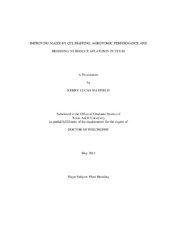| dc.description.abstract | Aflatoxins are potent carcinogens produced by the fungus Aspergillus flavus Link:Fr and are a significant preharvest problem in maize production in Texas, the southern US, and subtropical climates. Several sources of maize germplasm are available which reduce preharvest aflatoxin accumulation, but many of these sources lack agronomic performance for direct use as a parent in commercial hybrids. Tropical germplasm is a source of both resistance to aflatoxin accumulation resistance and agronomic performance traits. The goal of this study was to investigate germplasm for traits to reduce preharvest aflatoxin accumulation. The specific objectives of this research were: 1) to validate QTL estimates previously identified in lines per se and estimate new QTL associated with reduced aflatoxin accumulations and agronomic traits; 2) to evaluate agronomic characteristics of selections from a RIL population in testcrosses at multiple locations across Texas; and (3) to release agronomically desirable germplasm sources with reduced risk to preharvest aflatoxin accumulation.
A total of 96 QTLs were detected across fourteen measured traits using an RIL population of 130 individuals in testcross hybrids evaluated in five environments. Three QTL detected in per se analyses were also detected in hybrid testcrosses. Previously unreported QTL were detected on chromosomes 3, 4, 8 and 9.
Within each of the two years, neither subset of the RIL testcross hybrids produced grain yields equal to commercial hybrid checks in these trials, but one testcross in 2008 produced grain yield within 10 percent of commercial check hybrids and in 2009, five RIL testcrosses produced grain yield within 17 percent of the commercial check hybrids. Although RIL testcrosses did not yield more than the commercial checks, they will be a source of germplasm for reduced aflatoxin.
Improved sources of maize germplasm lines Tx736, Tx739, and Tx740 have been selected for adaptation to southern US and Texas growing environments with traits that reduce aflatoxin accumulation. Each of the lines in testcross accumulated significantly fewer aflatoxins than commercial hybrids in the trial. | en |


